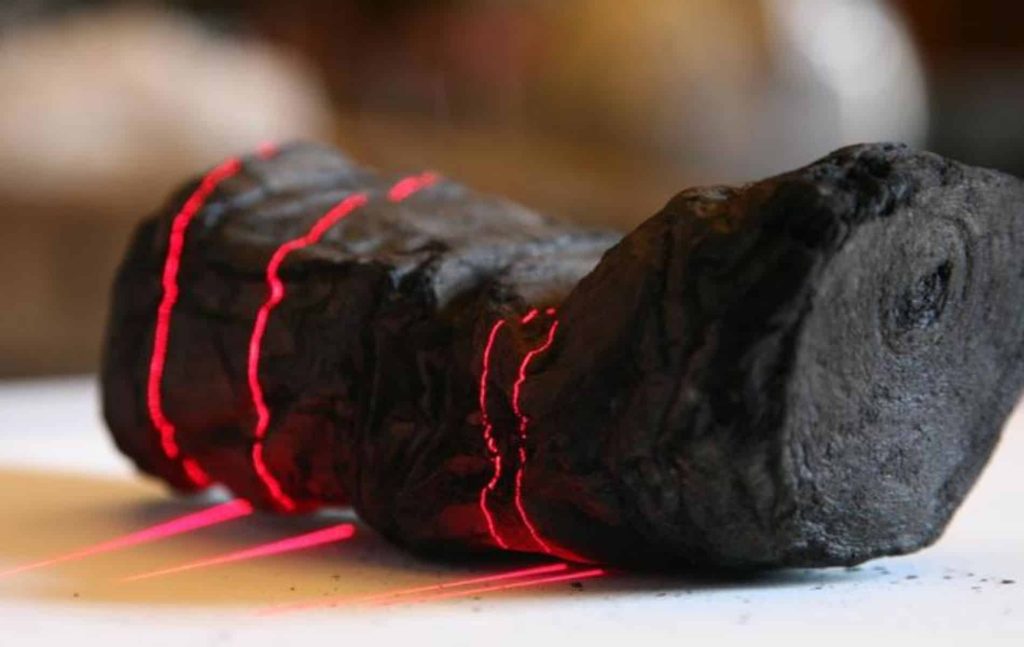purple. An American student, with the help of artificial intelligence, discovered this word in a scroll that was buried under lava, rocks and ash nearly 2,000 years ago during the eruption of Mount Vesuvius, at the same time as the famous eruption of Pompeii. It’s a monumental achievement: Never before have researchers been able to determine what was written on this charred scroll – which threatens to be crushed at the slightest touch. But it’s also basically a prelude to more. Much more!
It is the year 79 AD, and Mount Vesuvius – located on the western coast of present-day Italy – is erupting violently. The nearby city of Pompeii is completely buried under ash and stone. The Roman city of Herculaneum also disappears under semi-liquid lava, rocks and ash. It would take centuries for the two cities to be rediscovered and excavated. In 1752 they found something special in Herculaneum: a library of hundreds of manuscripts, which may have belonged to Julius Caesar’s father-in-law. Many of these scrolls are badly charred and threaten to crush at the slightest touch. However, curiosity wins out, and over time scholars open a number of these manuscripts. The scrolls are instantly destroyed and only very small fragments can be read. These fragments mainly reveal Greek philosophical texts. However, to this day there remain about 600 manuscripts so fragile that scholars do not dare to open them, and thus – to the dismay of many historians – their contents are in danger of remaining unknown.
purple
But there is hope. Because an American student managed to uncover the first word on such a charred, unopened scroll. With the help of artificial intelligence, he discovered a Greek word in the scroll that meant something like “purple.” It’s an exciting discovery. On the one hand, of course, because it fuels the hope that we will one day discover what is described in these charred manuscripts. But on the other hand, certainly also because the word “purple” is very rare in ancient texts.
Previous search
This discovery was preceded by years of research by various scientists. One of these researchers is Brent Sales, a professor at the University of Kentucky. He had previously made history by reading without opening an extremely fragile, burnt scroll that was found in Israel in 1970. To do this, he made a 3D cross-sectional scan of the scroll, which then enabled him to “virtually open the scroll” and read it (see video below).
Eventually, Sales and his colleagues were able to reveal that the scroll contained portions of the Bible’s Book of Leviticus. The research also seems to bring us one step closer to uncovering the contents of the Herculaneum Scrolls. But there was one problem. The ink used on the scroll from Israel contained minerals that showed up quite clearly in recent scans. But the Herculaneum Scrolls are written in carbon-based ink that hardly contrasts with the underlying papyrus – which also contains carbon -. This makes it more difficult to open and read menus by default. Until Sells realizes that the ink causes subtle changes in the papyrus that may be possible to detect with the help of artificial intelligence. Then he develops one Machine learningThe model should distinguish between written and unwritten pieces of papyrus based on those minor changes in the papyrus. Train him Machine learningModel by rendering CT scans of parts of already opened scrolls from Herculaneum. And successfully: the model turned out to be able to identify the part of it that was described based on minor changes in the papyrus.
Vesuvius challenge
The success of Sells and his colleagues caught the attention of two entrepreneurs who later launched the venture Vesuvius challenge Launched. With the challenge It holds a grand prize of $700,000. This money goes to the first person to read four passages of text from two charred but intact scrolls from Herculaneum. There are also smaller cash prizes for achievements along the way, such as a $40,000 cash prize for the person who deciphers the first word on one of the scrolls. In the search for those cash prizes (and everlasting fame), participants can shamelessly rely on the work of Sells and his colleagues. And so the scientists donated to the benefit Vesuvius challenge Thousands of 3D scans of the coiled coils and some parts of the coils already opened have been released. The software the researchers used to detect ink in the reels has also been released. All in the hope that others would use it to decipher the scroll’s contents.
The researchers certainly were not disappointed. Because many started working with programs and scans. Among them are people who devote themselves entirely to mapping the three-dimensional structure of the scrolls, and – once they are clear – to posing them virtually. By summer, hundreds of square centimeters of coils had already been opened! A major breakthrough came in August when one of the participants — after hours of staring at the virtually unrolled portions — discovered a “crack”: a pattern in the papyrus that seemed to indicate the presence of ink. It was a huge discovery, because ink had never before been discovered in an unopened scroll from Herculaneum! Naturally, the participants then went looking for more “patter.” But this search was difficult. Oddly enough, the “click” seemed very rare in parts of the scrolls that were actually open. Student Luke Variator also heard about this research on “pops” and decided to do it Machine learningA model that can detect such a “click”. He initially trained the model based on the detected “pop”, and then continued looking at other parts of the fascia. And with every “click” you discover, you get better and discover more “clicks,” making it better. The model soon began pointing out “cracks” that could not be seen with the naked eye. Soon, this discovered “click” also began to form what looked like letters and even words! Shortly after, Varitor – while searching for the $40,000 payment allocated to the first person to read a word on the scroll – presented the image below, taken from a piece of papyrus hidden deep within the scroll. Indeed, the first word is very clearly visible.
Meaning of violet
According to papyrologists, it says something like “purple” and this term may refer to paint or clothing. It’s a word that has never been found before in the Herculaneum manuscripts, says papyrologist Federica Nicolardi. “Purple paint was highly sought after in ancient Rome and was made from the glands of sea snails. So the term could refer to purple paint, or purple clothes, or even to the class of people who could afford it. But more important than this single word is that we something He can read. This means that it may be possible to reconstruct the text of the entire scroll!”
More words appear
What this pass is about remains a matter of speculation at the moment. But perhaps not for much longer. More words were now spotted near the word that Varitor first saw. These words seem to mean something like “achievable” and “comparable.” This set of words does not ring a bell among experts, so there is a good chance that the text on the scroll is not yet known to us.
Optimism is prevalent
The speed with which discoveries have been made about these manuscripts recently – with the help of prize money, of course – makes scholars optimistic that we will soon know more and these manuscripts will be read in their entirety again for the first time in 2,000 years. Sales points out that “these texts were written by human hands at a time when world religions were emerging, the Roman Empire still ruled, and many parts of the world were still unexplored.” “Many writings from that time have been lost.” It has long been thought that the Herculaneum manuscripts should also be considered lost. But scientists are now backing away from that. First we hope that the two central scrolls of Vesuvius challenge, but perhaps later also for those other 600 scrolls that are impossible to open. Historians expect it could provide a wealth of information about antiquity.
But analysis of the texts and conclusions about their historical significance will have to wait some time. First we need to clarify what exactly is in those scrolls. This research has Vesuvius challenge It has already gained tremendous momentum and will undoubtedly continue to gain momentum in the coming months; Challenge participants have until December 31, 2023 to decipher a larger portion of the scrolls and thus claim a prize of $700,000.

“Coffee buff. Twitter fanatic. Tv practitioner. Social media advocate. Pop culture ninja.”










More Stories
Which can cause an increase in nitrogen.
The Central State Real Estate Agency has no additional space to accommodate Ukrainians.
The oystercatcher, the “unlucky national bird,” is increasingly breeding on rooftops.